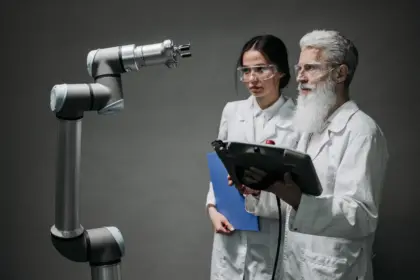AI in Medical Devices May Transform Healthcare

The article When We Put AI in Medical Devices, Magic Starts to Happen recently came across my news feed. It’s hard not to see how much artificial intelligence is being leveraged all around us, though I was surprised to learn that more than 350 AI-based medical devices have already been approved by the FDA. Many of these devices are already making big impacts in the healthcare industry. Specifically, implementation of computer vision techniques has had an amazing impact.
Examples of AI in Medical Devices
As we are all aware, the healthcare industry has been hit hard by staffing shortages, making it very challenging to schedule even simpler procedures such as an ultrasound.Caption Health is revolutionizing how ultrasounds are given. The ultrasound system they developed uses AI to guide nurses giving the ultrasound, even interpreting the ultrasound right on the screen. This allows a much wider range of healthcare workers to give ultrasounds, not just a specialized sonographer.
AI has also changed the way patients can get an MRI. Traditionally, MRI equipment filled an entire room, requiring patients to be transported to the equipment. Hyperfine’s development of their Swoop system - an AI enabled portable MRI allows the equipment to come to the patient, even into an operating room. Their implementation of computer vision provides the necessary image fidelity that the smaller hardware cannot natively provide.

Limiting the Expansion of AI
Dr. Kimberly Powell, vice president of healthcare at Nvidia, stated that there are some key areas of limitations to the growth of AI in healthcare. The availability of platforms powerful enough to handle sending the AI to other hardware or software without using the cloud is a primary challenge. The latency issues with moving significant amounts of image data to a cloud-based endpoint and the added risk of a network connection being a single point of failure are only a couple of the considerations making dependency on cloud processing less than desirable. This was the reason Nvidia created Clara Holoscan, one of 3 robotics platforms by Nvidia. This platform is designed to be the foundation of real-time intelligent instruments which do all processing on-device.
The lack of data available to train AI, especially regarding rare illness or disease, is another significant limiting factor. Dr. Powell suggests the solution here is more AI to create synthetic data, such as the 100,000 images of brains recently created by King’s College London I find this a fascinating methodology for the creation of training data. The team at King’s is hoping to expand the coverage of their data to any part of the human anatomy and across multiple types of medical imaging.
Nvidia is also working to address the need for the development of the complex AI algorithms through their AI framework MONAI. MONAI contains all the tools needed to label data, create synthetic data, train models, validate models in the real world, then connect them to the Clara Holoscan platform for deployment.
As The Refinery focuses our efforts as a MedTech software implementer, I continue to be more and more excited about these great advancements in technology, and the great opportunity they present to improve peoples’ quality of life. We really do “live in the future”.
Contents
Tags
Next Article
